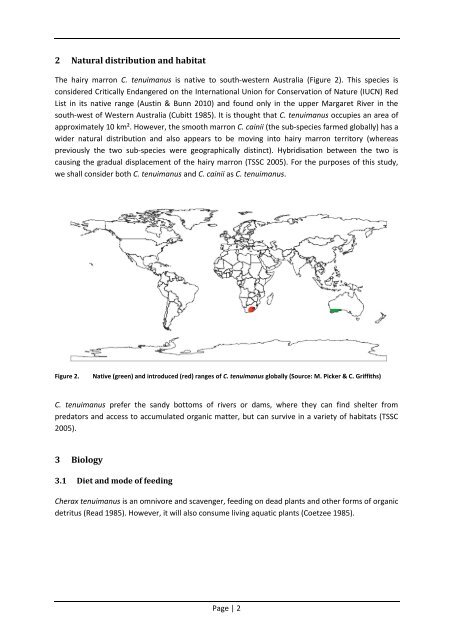Marron, freshwater crayfish Cherax tenuimanus - Department of ...
Marron, freshwater crayfish Cherax tenuimanus - Department of ...
Marron, freshwater crayfish Cherax tenuimanus - Department of ...
You also want an ePaper? Increase the reach of your titles
YUMPU automatically turns print PDFs into web optimized ePapers that Google loves.
2 Natural distribution and habitat<br />
The hairy marron C. <strong>tenuimanus</strong> is native to south-western Australia (Figure 2). This species is<br />
considered Critically Endangered on the International Union for Conservation <strong>of</strong> Nature (IUCN) Red<br />
List in its native range (Austin & Bunn 2010) and found only in the upper Margaret River in the<br />
south-west <strong>of</strong> Western Australia (Cubitt 1985). It is thought that C. <strong>tenuimanus</strong> occupies an area <strong>of</strong><br />
approximately 10 km². However, the smooth marron C. cainii (the sub-species farmed globally) has a<br />
wider natural distribution and also appears to be moving into hairy marron territory (whereas<br />
previously the two sub-species were geographically distinct). Hybridisation between the two is<br />
causing the gradual displacement <strong>of</strong> the hairy marron (TSSC 2005). For the purposes <strong>of</strong> this study,<br />
we shall consider both C. <strong>tenuimanus</strong> and C. cainii as C. <strong>tenuimanus</strong>.<br />
Figure 2.<br />
Native (green) and introduced (red) ranges <strong>of</strong> C. <strong>tenuimanus</strong> globally (Source: M. Picker & C. Griffiths)<br />
C. <strong>tenuimanus</strong> prefer the sandy bottoms <strong>of</strong> rivers or dams, where they can find shelter from<br />
predators and access to accumulated organic matter, but can survive in a variety <strong>of</strong> habitats (TSSC<br />
2005).<br />
3 Biology<br />
3.1 Diet and mode <strong>of</strong> feeding<br />
<strong>Cherax</strong> <strong>tenuimanus</strong> is an omnivore and scavenger, feeding on dead plants and other forms <strong>of</strong> organic<br />
detritus (Read 1985). However, it will also consume living aquatic plants (Coetzee 1985).<br />
Page | 2
















